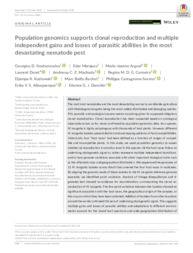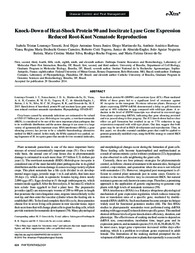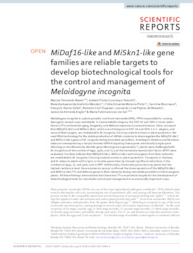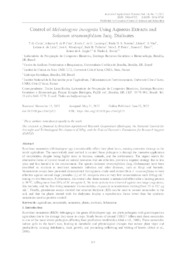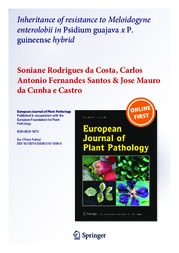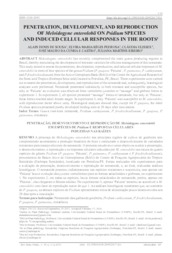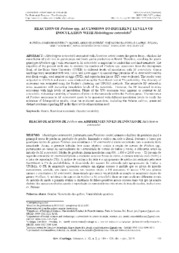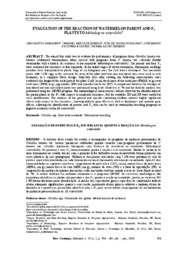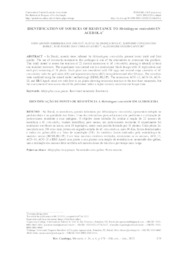Search Publications
Filter by:
| Author(s): KOUTSOVOULOS, G. D.; MARQUES, E.; ARGUEL, M.-J.; DURET, L.; MACHADO, A. C. Z.; CARNEIRO, R. M. D. G.; KOZLOWSKI, D. K.; BAILLY-BECHET, M.; CASTAGNONE-SERENO, P.; ALBUQUERQUE, E. V. S.; DANCHIN, E. G. J.
|
| Author(s): LOURENCO, I. T.; SOUZA JÚNIOR, J. D. A.; MARTINS-DE-SA, D.; VIANA, A. A. B.; CARNEIRO, R. M. D. G.; TOGAWA, R. C.; ALMEIDA-ENGLER, J. de; BATISTA, J. A. N.; SILVA, M. C. M. da; GROSSI-DE-SA, M. F.
|
| Author(s): BASSO, M. F.; LOURENCO-TESSUTTI, I. T.; MENDES, R. A. G.; PINTO, C. E. M.; BOURNAUD, C.; GILLET, F.-X.; TOGAWA, R. C.; MACEDO, L. L. P. de; ENGLER, J. d A.; GROSSI-DE-SA, M. F.
|
| Control of Meloidogyne incognita using aqueous extracts and Solanum stramonifolium Jacq. dialisates. Author(s): COSTA, T. G.; CRUZ, A. S. de P.; LOURENÇO, E. D. de O.; FERREIRA, P. D. S.; VIOL, L. C. S.; LIMA, L. A. de; MENDONCA, J. L. de; PINHEIRO, J. B.; POLEZ, V. L. P.; DIAS, S. C.; ENGLER, J. de A.; ROCHA, T. L. Root-knot nematodes (Meloidogyne spp.) considerably affect their plant hosts, causing extensive damage in the world agriculture. The most widely used method to control these pathogens is through the i... ... |
| Author(s): COSTA, S. R. da; SANTOS, C. A. F.; CASTRO, J. M. da C. e Inheritance of the resistance to nematodes has been studied on many different crops, however to our knowledge, no data are available for guava species. The basic genetic resistance parameters to Meloi... ... |
| Author(s): SOUSA, A. D. de; PEDROSA, E. M. R.; ULISSES, C.; CASTRO, J. M. da C. e; RIBEIRO, J. M. Meloidogyne enterolobii has severely compromised the main guava producing regions in Brazil, thereby stimulating the development of resistant varieties for efficient management of this nematode. This... ... |
| Author(s): OLIVEIRA, P. G. de; QUEIROZ, M. A. de; CASTRO, J. M. da C. e; RIBEIRO, J. M.; OLIVEIRA, R. S. de; SILVA, M. J. L. da Meloidogyne enterolobii associated with Fusarium solani causes the guava decay, which is the main factor of yield loss in guava crops and limits guava production in Brazil. Therefore, searching for gu... ... |
| Author(s): PINTO, T. J. B.; CUNHA, D. F.; SILVA, G. O. da; PINHEIRO, J. B.; CORREIA, V. R.; RAGASSI, C. F.; CARES, J. E. The root-knot nematode, Meloidogyne enterolobii, is an important pathogen of numerous crops, including the so-called pulses. Hence, it is necessary to identify genetic resistance, as it is the most ef... ... |
| Author(s): DAMACENO, L. S.; QUEIROZ, M. A. de; DIAS, R. de C. S.; CASTRO, J. M. da C. e; TEIXEIRA, F. A. The aim of this study was to evaluate the performance of progenies from Citrullus lanatus var. lanatus (cultivated watermelons) when crossed with progenies from C. lanatus var. citroides (fodder water... ... |
| Author(s): SANTOS, J. L. F. dos; SOUZA, F. de F.; BOREL, J. C.; CASTRO, J. M. da C. e; CAPUCHO, A. S. In Brazil, acerola trees infested by Meloidogyne enterolobii present lower yield and fruit quality. The use of rootstocks resistant to this pathogen is one of the alternatives to overcome this problem... ... |
Observation
Some of Embrapa's publications are published as ePub files. To read them, use or download one of the following free software options to your computer or mobile device. Android: Google Play Books; IOS: iBooks; Windows and Linux: Calibre.
Access other publications
Access the Agricultural Research Database (BDPA) to consult Embrapa's full library collection and records.
Visit Embrapa Bookstore to purchase books and other publications sold by Embrapa.

